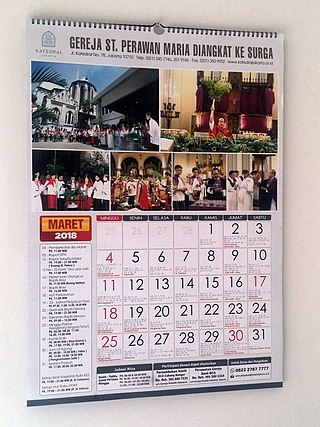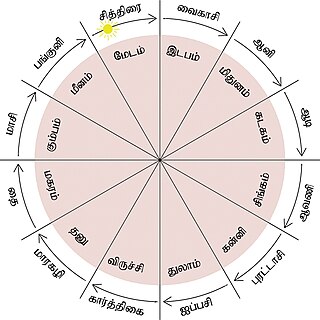Related Research Articles

A calendar is a system of organizing days. This is done by giving names to periods of time, typically days, weeks, months and years. A date is the designation of a single and specific day within such a system. A calendar is also a physical record of such a system. A calendar can also mean a list of planned events, such as a court calendar, or a partly or fully chronological list of documents, such as a calendar of wills.

The traditional Chinese calendar is a lunisolar calendar, combining the solar, lunar, and other cycles for various social and agricultural purposes. More recently, in China and Chinese communities the Gregorian calendar has been adopted and adapted in various ways, and is generally the basis for standard civic purposes, though also incorporating traditional lunisolar holidays. Also, there are many types and subtypes of the Chinese calendar, partly reflecting developments in astronomical observation and horology, with over a millennium's worth of history. The major modern form is the Gregorian calendar-based official version of Mainland China, though diaspora versions are also notable in other regions of China and Chinese-influenced cultures; however, aspects of the traditional lunisolar calendar remain popular, including the association of the twelve animals of the Chinese Zodiac in relation to months and years.

A lunisolar calendar is a calendar in many cultures, incorporating lunar calendars and solar calendars. The date of lunisolar calendars therefore indicates both the Moon phase and the time of the solar year, that is the position of the Sun in the Earth's sky. If the sidereal year is used instead of the solar year, then the calendar will predict the constellation near which the full moon may occur. As with all calendars which divide the year into months there is an additional requirement that the year have a whole number of months. In some cases ordinary years consist of twelve months but every second or third year is an embolismic year, which adds a thirteenth intercalary, embolismic, or leap month.
A month is a unit of time, used with calendars, that is approximately as long as a natural orbital period of the Moon; the words month and Moon are cognates. The traditional concept of months arose with the cycle of Moon phases; such lunar months ("lunations") are synodic months and last approximately 29.53 days, making for roughly 12.37 such months in one Earth year. From excavated tally sticks, researchers have deduced that people counted days in relation to the Moon's phases as early as the Paleolithic age. Synodic months, based on the Moon's orbital period with respect to the Earth–Sun line, are still the basis of many calendars today and are used to divide the year.
The Iranian calendars or Iranian chronology are a succession of calendars created and used for over two millennia in Iran, also known as Persia. One of the longest chronological records in human history, the Iranian calendar has been modified many times for administrative, climatic, and religious purposes. The most influential person in laying the frameworks for the calendar and its precision was the 11th century Persian polymath, Omar Khayyam. The modern Iranian calendar is currently the official civil calendar in Iran.
The Hindu calendar, also called Panchanga, is one of various lunisolar calendars that are traditionally used in the Indian subcontinent and Southeast Asia, with further regional variations for social and Hindu religious purposes. They adopt a similar underlying concept for timekeeping based on sidereal year for solar cycle and adjustment of lunar cycles in every three years, but differ in their relative emphasis to moon cycle or the sun cycle and the names of months and when they consider the New Year to start. Of the various regional calendars, the most studied and known Hindu calendars are the Shalivahana Shaka found in the Deccan region of Southern India and the Vikram Samvat (Bikrami) found in Nepal and the North and Central regions of India – both of which emphasize the lunar cycle. Their new year starts in spring. In regions such as Tamil Nadu and Kerala, the solar cycle is emphasized and this is called the Tamil calendar and Malayalam calendar and these have origins in the second half of the 1st millennium CE. A Hindu calendar is sometimes referred to as Panchangam (पञ्चाङ्गम्), which is also known as Panjika in Eastern India.

The Tamil calendar is a sidereal solar calendar used by the Tamil people of the Indian subcontinent. It is also used in Puducherry, and by the Tamil population in Sri Lanka, Malaysia, Singapore, Myanmar and Mauritius.
Public holidays in Somaliland are based on two official calendar systems: the Gregorian calendar primarily, and the Islamic lunar calendar for religious holidays.

The Rahanweyn, also known as the Digil and Mirifle are a major Somali clan. It is one of the major Somali clans in the Horn of Africa, with a large territory in the densely populated fertile valleys of the Jubba and Shebelle rivers and the areas inbetween which are mainly inhabited by settlers from the Digil and Mirifle lineages.

The endoglossic language of Somalia has always been Somali, although throughout Somalia's history various exoglossic languages have also been used at a national level.

Tishtrya is the Avestan name of a Zoroastrian benevolent divinity associated with life-bringing rainfall and fertility. Tishtrya is Tir in Middle- and Modern Persian. As has been judged from the archaic context in which Tishtrya appears in the texts of the Avesta, this divinity is almost certainly of Indo-Iranian origin. Tir is associated with the star Sirius, called Tishtar, in New Persian.
The Sun Java System Calendar Server was Sun's calendar (scheduling) server. The currently available version is 6.3 which is now part of the Sun Java System Communications Suite.

Public holidays in Somalia are based on two official calendar systems: the Gregorian calendar primarily, and the Islamic lunar calendar for religious holidays.
This is a list of public holidays in Djibouti. The country uses two official calendar systems: the Gregorian calendar primarily, and the Islamic lunar calendar for religious holidays.
A season is a division of the year based on changes in weather, ecology, and the number of daylight hours in a given region. On Earth, seasons are the result of the axial parallelism of Earth's tilted orbit around the Sun. In temperate and polar regions, the seasons are marked by changes in the intensity of sunlight that reaches the Earth's surface, variations of which may cause animals to undergo hibernation or to migrate, and plants to be dormant. Various cultures define the number and nature of seasons based on regional variations, and as such there are a number of both modern and historical cultures whose number of seasons varies.
A tropical year or solar year is the time that the Sun takes to return to the same position in the sky – as viewed from the Earth or another celestial body of the Solar System – thus completing a full cycle of astronomical seasons. For example, it is the time from vernal equinox to the next vernal equinox, or from summer solstice to the next summer solstice. It is the type of year used by tropical solar calendars.
At Tiri is a village located in the Caza of Bint Jbeil in the Nabatiye Governorate in Lebanon. It is also the location of two pre-historic archaeological sites.
The Gaalje'el, , or Habar Tigaalle is one of the largest Somali clans, whose origins trace back to Samaale. The Galje'el clan belong to the Major Saransor clans who is also sub clan of Wider Gardhere Samaale clans. The Clan is well known for their fierce battles against the Italian colonialists who were unable to occupy their land. This clan is also known for fighting against the Abyssinians for a long time who wanted to expand in the area of the Shabelle River, one of the biggest battles was the Battle of Dafet, at that time Abyssinians want to capture Dafet, entering from Shabelle River, but Gaalje'el fought back and defeated Abyssian and pushed them back; 1500 Amhara horsemen were killed in that battle.
Hawa Jibril (1920–2011) was a Somali poet, known especially for her work in the buraanbur genre.
Ahmed Dhagah District is a district in Hargeisa, Somaliland. It is one of the eight administrative districts of Hargeisa City.
References
- 1 2 Hussein, y Said M-Shidad (31 December 2011). "The Somali Calendar: An Ancient, Accurate Timekeeping System" (PDF). Retrieved 5 October 2023.